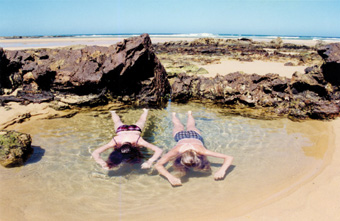Beyond the personal
Jacqueline Millner
 Sandy Edwards, Marina and Laura in Lady Grounds Pool,
Sandy Edwards, Marina and Laura in Lady Grounds Pool,
Bithry’s Inlet, Tanja, NSW, 1998
Indelible represents the suite of images that remained after photographer Sandy Edwards spent months viewing, re-viewing and culling the hundreds of rolls of colour film of family and friends that she had shot over the last decade. The images record Edwards’ visits to some of her favourite haunts, such as New York City and the New South Wales south coast, as well as documenting certain rites of passage and leisure activities of her close personal network. A child opens a Christmas present while another squirts a hose at the camera; a pair of adolescents pose in formal wear while others lie face down on the surface of a rock pool; a girl surveys a wedding reception, while another warms her legs by a fire.
The challenge faced by the artist, as Edwards herself describes it in her room-sheet notes, was the transformation of these images from personal snapshots into an exhibition with broader, or ‘universal’ appeal. Edwards has attempted to achieve this through honing in on content, selecting representations of those moments in life to which most of us are witness, events that mark the passage of time or personal change, such as weddings and birthdays, holidays and house-warmings.
There are several perils in such an approach. One is the by now familiar dubiousness of the traditional documentary photographer’s credo of truth and objectivity. Another is the equally problematic nature of any appeal to the ‘universal’, whereby culturally specific assumptions are necessarily made but not always acknowledged. Further, there is the related risk that in aiming for the general, one might lose the poignancy of the particular.
Edwards may have run these risks, but her erudition and experience allow her to navigate them, albeit with varying degrees of success. Her role in the documentation process—the images are to some degree autobiographical, with the artist herself appearing on occasion—is explicitly acknowledged, underlining the subjective nature of photography. The titles of the photographs locate them very specifically in time and place, as does the frequent reliance on the genre of portraiture that heightens the individual identity of the subjects; clearly these images are less universal than representative of a particular class and lifestyle. However, despite this, some of Edwards’ images fail to engage, and appear to suffer from a lack of intimacy. Perhaps, in seeking a more public mode of address, Edwards has at times sacrificed a personally charged register.
There is a sense of emotional reticence about some of the images, as if any scenes deemed too intimate or revealing have been edited out. For example, awkward moments are not really tackled, although there is a moving hint of discord in one title that tells us the artist’s mother no longer wishes to be her daughter’s subject. Indeed, at times the portrayals tip into the anodyne, remaining unremarkable and prosaic, not unlike those shots in an ordinary family album that attempt to evoke the significance of events through their sheer quantity rather than through a definitive image.
As a result, it is those photographs tending to the abstract, which demand a shift in the mode of spectatorship, that are the strongest and most evocative. When Edwards’ unmistakable eye for colour and composition is most in evidence, her photographs come alive for this viewer, as in the vibrant contrasts in Merilee’s hands, where fingers are outstretched to a pot belly stove and clothes highlight pattern and colour; or the cool sinuousness of Lisa’s legs in mum and dad’s pool; or the delight in the abstract arrangements haphazardly created by Adrian’s sarong blowing on my mother’s clothesline and Byron Bay Classics cozzies. The appeal of such images lies largely in Edwards’ ability, through her formal strategies, to transform the unremarkable into the aesthetically delightful. Her photographs infuse the ordinary with beauty in such a way that the viewer can bring a refreshed vision to his/her own surroundings, with eyes more attuned to colour, pattern, correspondence.
One correspondence that repeatedly structures Edwards’ images is between people and nature. A certain unapologetic Romanticism permeates her compositions: people are often shot in natural landscapes, or at least in contact with natural elements such as fire and water, with an emphasis on ‘naturalness’, ‘immediacy’ and ‘sensation.’ The urban shots, by contrast, tend to be less inhabited: fragments of the built environment, such as a neon sign or pedestrian crossing, stand as synecdoches for the city, while portraits shot in the street are closely cropped to limit the allusion to place.
While the emotional reticence and prosaic nature of some of the images detract from their power, this is counterbalanced by the formal rigour, aesthetic empathy and affirmation of human/nature interaction in others. On viewing this exhibition, I was reminded of Susan Sontag’s observations in her recent book about the ethically dubious nature of “regarding the pain of others.” Perhaps in offering us images of everyday beauty, Edwards is honing our powers of attention more effectively.
Sandy Edwards, Indelible, Stills Gallery, Sydney, March 17-April 17
RealTime issue #61 June-July 2004 pg. 45






